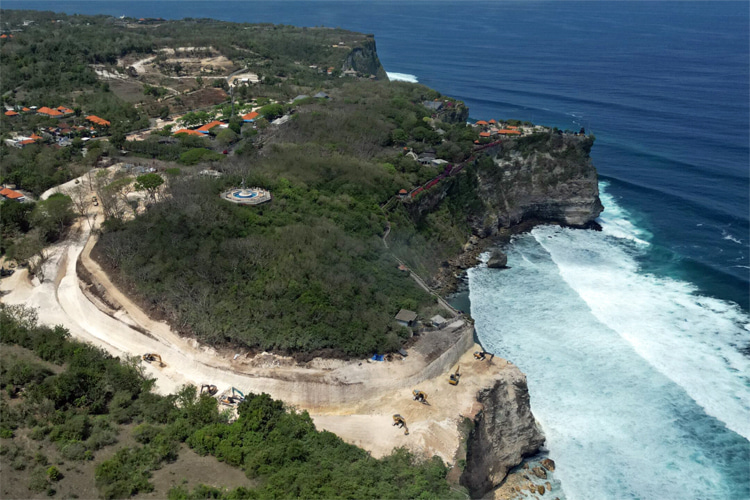Shocking concrete seawall threatens Uluwatu cliffs and waves

The Indonesian authorities are building a concrete seawall around the Uluwatu cliffs to prevent the Pura Luhur Temple from sliding into the Indian Ocean.
The decision to proceed with the controversial $5 million construction raised the alarm among the local surfing community and several non-governmental organizations.
The plan is to create a protection ring that saves the sacred Uluwatu temple and strengthens local river systems and waterways.
The goal is to build a coastal road and an 82-foot (25-meter) seawall that protect the cliffs and human-made structures from collapsing.
The cracks on the southern cliff face are visible, and the situation is not new.
The initial signs of deterioration in the integrity of the coastal feature date back to 1992, when an earthquake compromised the tall and steep rocky faces.
The local government limited the number of visitors allowed in the religious site and area, but it was not enough.
Now that there’s imminent danger and the risk of losing the Pura Luhur Temple, the Balinese authorities started tearing apart the iconic cliff to make way for the road and the concrete seawall that will wrap its base.
The natural beauty that has ever since become a symbol of this surfing paradise will be replaced by a wall of concrete.
Unexpected Consequences
The consequences of these actions are not yet known.
Nevertheless, the always-sensitive nearby ecosystem will probably witness changes in natural sand movements, water currents, and wave patterns.
The local community feels that they were not consulted before the start of the brutal construction of the fortress wall.
There’s also the feeling that the degradation of the cliffs is not due to swells but to excessive rainwater.
But there are also locals who fear that their publicly expressed concerns could be seen as criticism against Bali’s spiritual, cultural, and religious traditions.
In the world’s most populous Muslim nation, Bali is mostly Hindu, making political decision-making even more complex and sensitive.
Bali has 4.4 million inhabitants, 87 percent of which are Hindus. Around 80 percent of the island’s economy is tourism-based, part of it driven by surfing.
Uluwatu is home to five outstanding waves that regularly attract surf travelers from around the world.
The Pura Luhur Temple area, in particular, is also known for three peaks: Secrets, Lurches, and Temples.
One thing is for certain: the excavators and heavy demolition machinery have already brought part of the cliff down, and that cannot be undone.
240,000 Surfers Visit Uluwatu
Save the Waves Coalition is trying to raise awareness of the importance of this place for everyone.
“We recognize the spiritual, cultural, and economic significance of Pura Luhur Uluwatu to the people of Bali,” the organization noted.
“This ancient Hindu temple has stood for over a thousand years and attracts thousands of visitors every day.”
“Its protection and preservation align with the values held by all communities to safeguard their cultural resources for future generations.”
“However, like many other places across Bali and around the world, we are concerned about the potential environmental risks this project poses to the surrounding marine and surf ecosystems.”
“To our knowledge, no Environmental Impact Assessment (EIA) has been undertaken for this proposed road project.”
“Without such an assessment, it is impossible to quantify how Uluwatu’s biodiverse surf ecosystems may be affected.”
“Uluwatu’s coral reefs, which create world-class waves, also support rich marine life, including dugongs (a relative of the manatee), sea snakes, reef sharks, turtles, and a variety of reef fish species.”
“There have even been sightings of orca whales in the area.”
In addition to environmental concerns, it is important to assess whether the project will impact wave quality.”
“Uluwatu’s wave quality attracts surfers from around the world.”
“A 2014 study by Save The Waves and conservation partners found that over 240,000 surfers visit Uluwatu and contribute $35 million (USD) to the economy annually.”
Ultimately, the preservation of Pura Luhur’s religious relevancy is mandatory. It is also a source of income for the region, thanks to the number of tourists it welcomes every day.
However, a massive wall of concrete is hardly compatible with the region’s untouched natural beauty and won’t certainly go unnoticed by visitors.
On top of all that, it’s not the first or second time a similar project destroys another source of revenue for local economies.
The cards are on the table. It’s in the hands of those in power to take full responsibility for their actions.
Harms to Nature can rarely be reverted.
Words by Luís MP | Founder of SurferToday.com



